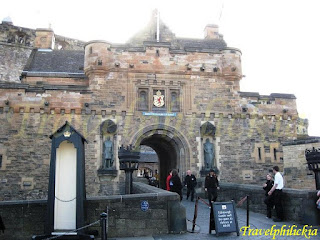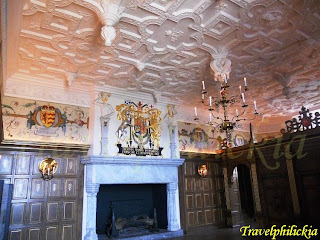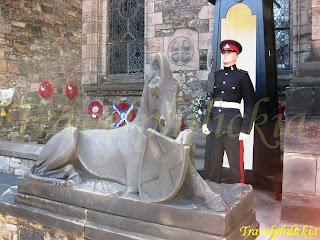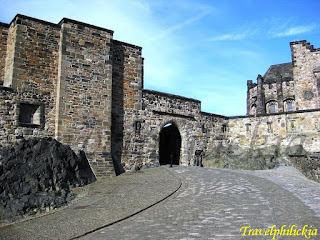After work, my colleague and I went to Houky for dinner before heading to the train station. Took train at 1737 hours from Neuchâtel to Geneva Train station. The cost of the return train tickets cost CHF 44. After custom clearance, we checked in our Swiss Air flight LX 358 at 2035 hours. Seats are comfortable and interestingly there are screens (left photo below) showing documentaries and cartoons after take-off. Simple light snacks of bread and hot beverage were served (right photo below) during the short journey.


The flight reached Heathrow Airport at about 9.20 pm. After custom clearance, we then took the complementary shuttle van to Sixt service centre near Heathrow Airport. This was followed by some verification and documentation before we drove to London Stansted Airport to pick up another colleague who would be joining us in this trip. We didn't know that Heathrow and Stansted airports are directly opposite each other with London City located between them. Thus it took us more than an hour's drive to reach Stansted Airport. It was already closed to mid-night when we departed from the Stansted and headed towards Birmingham. By the time we reached Apollo Hotel, it was about 2 am. After some wash-up, we had a good rest for the night.
Day Two
Woke up at about 8 am and we paid £ 5 per person for our breakfast at Apollo Hotel café. Next we drove up to Edinburgh. Beautiful landscapes and weather caught our sights during the drive (photos below).




We had coffee at one of the café outlets known as 'Coasta' along the motorways. As the sceneries was too beautiful, we even stopped along the road to take pictures (photos below).


Edinburgh City
Edinburgh (爱丁堡) is capital and second largest city in Scotland. The well-known Edinburgh International Festival is held there annually. Historic sites in Edinburgh include Edinburgh Castle, the Palace of Holyroodhouse, the churches of St. Giles, Greyfriars and the Canongate, and the extensive Georgian New Town built in the 18th/19th centuries.
 |
The Old Town and New Town districts of Edinburgh were listed as World Heritage Site by UNESCO in 1995. |
Edinburgh Castle
From the foot of hill, the Edinburgh Castle (photos below) looks very fairy-tale like which fits the image of Hogwarts School in Harry Potter series.


Edinburgh Castle has played many roles over centuries. It has been a residence for Scotland's monarchs, a prison for her enemies, a repository for her treasures – but it has always been a military stronghold. To this day, the Scottish Army has a military and ceremonial presence at the castle.
The Gatehouse (left photo below) was built in 1888 with the sole intention of making the castle look more imposing. It replaced a much simpler 17th century gate. The Scottish Royal Arms (right photo below) is represented on gatehouse together with a banner below that inscribed with a Latin motto of Scottish Army regiments: "NEMO : ME : IMPUNE : LACESSIT", which translated as "No one harasses me unpunished". At both sides are bronze statues of King Robert the Bruce (bottom left photo) and Sir William Wallace (bottom right photo) set into the façade of the gate. They are added in 1929 to mark the 600th anniversary of Bruce's death.




The Portcullis Gate (photos below) is a formidable entrance built as the principle gateway into the castle after the Lang Siege ended in 1573. It marks entrance to the Middle Ward of the Castle. Originally the gate had four barriers – an iron portcullis and three pairs of wooden doors. Now visitors can still see the iron crooks on which the heavy doors were hung.


The Argyle Battery (left photo below) was built in 1730s. These six guns are not the original armament, but on loan from the Royal Armories. They are cast-iron, muzzle-loading 18-pounders, made around 1810 (right photo below).


Views from the Castle were outstanding. On the north (left photo below) is the 18th century New Town - one of the greatest works of Georgian town-planning in the British Isle. Northeast view (right photo below) showed the Scott Monument, Princes Mall and the Calton Hill.


The exhibition on 'The Honors of the Kingdom' is the highlight of this castle and should not to be missed. It is located at the Crown Room and visitors have to walk up a flight of stairs (left photo below) before reaching the exhibition.
The story begins with Robert the Bruce being crowned in 1306 (right photo below).


The Honors of the Kingdom – the Crown, Sceptre and Sword of State – are the oldest crown jewels in the British Isle. The Sword of State was presented to James IV by Pope Julius II in 1507 (left photo below). Whereas the Crown was made for James V in 1540 by an Edinburgh goldsmith (right photo below). They were first used together for the coronation of Mary Queen of Scots in 1543.


However from 1651 to 1660, they lay buried to preserve them from the clutches of Oliver Cromwell (left photo below). After the 1707 Treaty of Union, they were locked away in the Crown Room. Until Walter Scott in 1818, with Royal approval, opened the oak chest (right photo below) and found them intact after being kept for 111 years.


These treasures are exhibited inside the Crown Room with tight security and no photographs allowed. Only through the information panels (photos below) that visitors can gain a better understanding of these valuable jewels.


The other important exhibit is the Stone of Destiny. This stone is a coarse-grained sandstone block measuring 67 x 42 x 26.5 cm and weighs 152-kg. For centuries the Stone of Destiny served the seat on which the Scottish Kings were enthroned at Scone, near Perth, Scotland. Then, in 1296, Edward I of England, had it forcibly removed and kept in Westminster Abbey in London where it was enclosed within a new throne – the Coronation Throne. Since then, the stone has been used in coronation ceremonies of most monarchs of England from 1714. On Nov 30, 1996 this ancient stone was returned back to Scotland and now exhibited in the Crown Room besides the Honors of Scotland. Only when there is a coronation in Westminster Abbey that this stone will ever leave Scotland.
The Royal Palace (left photo below) was the royal residence in the castle, which were the residence of the later Stewart monarchs. It was begun in the mid 15th century, during the reign of James IV, and it originally communicated with David's Tower. The building was extensively remodeled for the visit of James VI to the castle in 1617, when state apartments for the king and queen were built.
The cramped birthchamber (right photo below) was where Mary Queen of Scots gave birth to her only child – James VI in 1603.


The Laich Hall (left photo below) was recently restored back to the decorations in 1617 which was originally used to serve as an outer reception room and dinning chamber for King James VI.
Completed in 1511, the Great Hall (right photo below), measures 29 by 12.5 meters, was intended to serve as a place of ceremony in the castle.


The Scottish National War Memorial (left photo below) was officially opened in 1927. The building was originally a castle church of St Mary but was later converted into ammunition store in 1530s. This memorial now commemorates the dead of First and Second World Wars, and also military campaigns since 1945. A stylized unicorn (right photo below), supporter of the Royal Arms of Scotland, guards the entrance to the War Memorial together with the armed sentry.


The vaults beneath the Crown Square are bleak spaces that were used as prisons for centuries. The cells (photos below) have been reconstructed to show how they would have looked in the late 18th century.


The prison doors once held captive thousands of prisoners of war through three major wars: the Seven Years War (1756-63), the War of American Independence (1776-83) and The Napoleonic Wars (1793-1815). Some of the graffiti (photos below) made by the prisoners showed that they sailed in several kinds of ships before reaching the castle.


The military prison (photos below) was built in 1842 for defaulting soldiers from the garrison, for offences such as 'drunk on guard'. In the 1880s, it was extended by increasing the number of cells from 12 to 16 in response to new health regulations.


Independent museums devoted to two of Scotland's oldest regiments are housed in the New Barracks and the Drill Hall opposite. Many important exhibits are dedicated to the history and honor of the regiments (photos below).




The Foog's Gate (left photo below) was built in the 17th century, during a major fortification of the castle commissioned by King Charles II. However the origin of the name is unknown. Walls on both sides of the gate have openings for cannons and muskets.
The Governor's house (right photo below) was built in 1742 for the castle governor. Lodging for his principal staff officers, the mater gunner and storekeeper, were provided in the two wings. The building is now an officer's mess for the garrison stationed in the castle.


Edinburgh Castle is one of the few ancient castles in Britain that still has a military garrison, mainly for ceremonial and administrative purposes. Public duties performed by the garrison include guarding the Honours of Scotland, and armed sentries stand watch at the castle gatehouse outside opening hours. We were lucky to witness the changing of these guards (photos below) when we were to leave the castle.


Opening hours of the Edinburgh Castle is 0930 to 1800 hours (Apr to Sep) or 0930 to 1700 hours (Oct to Mar). Admission cost is £ 15 per adult during peak period (Jun to Sep) or £ 14 during off-peak period (Oct to May).
The Royal Mile
The Royal Mile is a succession of streets which form the main road of the Old Town of the city of Edinburgh. As the name suggests, the Royal Mile is approximately one Scots mile long, and runs between two foci of history in Scotland, from Edinburgh Castle at the top of the Castle Rock down to Holyrood Abbey. It is still possible, among 66 alleys and closes off the main street, to sense Edinburgh's medieval past. The Royal Mile is now a diverse mix of tourist shops and eateries.
Starting from the Edinburgh Castle, The Hub (left photo below), easily recognized by its characteristic spires. It is the headquarters of the Edinburgh International Festival.
St. Giles Cathedral (right photo below) is the principal place of worship of the Church of Scotland in Edinburgh. Its distinctive crown steeple is a prominent feature of the city skyline, at the mid point of the Royal Mile.


The Mercat Cross (left photo below) marks the city centre. It was here that Bonnie Prince Charlie was proclaimed King in 1745. Diagonally opposite the Cross is The City Chambers (right photo below) built in 1750s is where the City of Edinburgh Council meets.


Further down the street is Tron Kirk (left photo below) that was built in 1630 for the Presbyterians who left St. Giles Cathedral when it came under the control of the Bishop of Edinburgh.
Until the 18th century most residents in Edinburgh lived along and underneath the Royal Mile and Cowgate. The old abandoned cellars and basements, which lacked any proper water supply, daylight or ventilation, were once centers of domestic life and industry. Anchor Close (right photo below) is one of such famous areas linking the Royal Mile to Cockburn street.


Dinner at ClamShell
As we were tired from the Castle visit and walking along the Royal Mile, we decided to have our dinner in this ClamShell eatery (left photo below) located at 148 High Street of Royal Mile. Ordered a fried fillet and Mango ice tea for £ 6 (right photo below) and coleslaw at £ 1.30 for myself.


Greyfriars Bobby
Greyfriars Bobby was a Skye Terrier who became famous in the 19th-century. After the death of his owner, John Gray, the dog spent 14-years guarding his owner's grave until he died on 14 January 1872. A year later, Lady Burdett-Coutts had a statue and fountain erected (photos below) to commemorate him. This monument is located at the southern end of the George IV Bridge.


The Elephant House
The Elephant House (left photo below), opened in 1995, was made famous as the place of inspiration to writers such as J.K. Rowling, who sat writing much of her early novels in the back room overlooking Edinburgh Castle (right photo below). This café even claims that it is the birthplace of Harry Potter.


Bridges in Edinburgh
Two bridges spanned over the railway tracks that connects the Old Town to New Town of Edinburgh. North Bridge, opened in 1772, is a road bridge and street linking the High Street with Princes Street. Situated on the bridge is a war memorial which memorializes soldiers of the King's Own Scottish Borderers killed in campaigns between 1878 and 1902 (left photo below). The other bridge is Waverley Bridge (right photo below) which linked Market Street to Princes Street.


Scott Monument
The Scott Monument (left photo below) is a Victorian Gothic monument to Scottish author Sir Walter Scott (right photo below). The tower is 61.11- meters high and has a series of viewing decks.


Hard Rock Café Edinburgh
Located at 20 George Street at New Town of Edinburgh, this Hard Rock Café (left photo below) has something that is different from the rest of the cafés throughout the world. Of course there's city-specific souvenir for collectors, such as the Edinburgh Hard Rock Bears (right photo below).


Princes Street Gardens
Princes Street Gardens is a public garden in the centre of the city with Edinburgh Castle as its backdrop. There are many monuments and statues within the garden, such as the Scottish poet: Allan Ramsay (left photo below). Many wooden benches (right photo below) outside the garden fences along Princes Street were donated generously by various groups and people from the society.


Together with my colleagues, we walked towards the car park to get our car, and then drove to Northfield House Hotel to check-in for the night.
 Posts RSS
Posts RSS


